
The Accipitridae is one of the three families within the order Accipitriformes, and is a family of small to large birds of prey with strongly hooked bills and variable morphology based on diet. They feed on a range of prey items from insects to medium-sized mammals, with a number feeding on carrion and a few feeding on fruit. The Accipitridae have a cosmopolitan distribution, being found on all the world's continents and a number of oceanic island groups. Some species are migratory. The family contains 255 species which are divided into 70 genera.
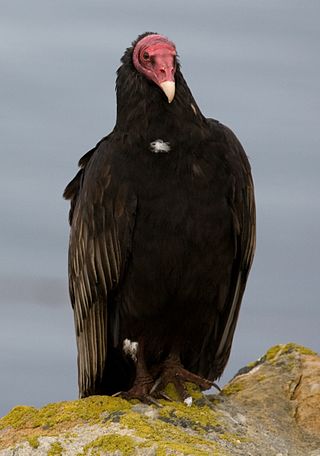
Cathartidae, known commonly as New World vultures or condors, are a family of birds of prey consisting of seven extant species in five genera. It includes five extant vultures and two extant condors found in warm and temperate areas of the Americas. They are known as "New World" vultures to distinguish them from Old World vultures, with which the Cathartidae does not form a single clade despite the two being similar in appearance and behavior as a result of convergent evolution.
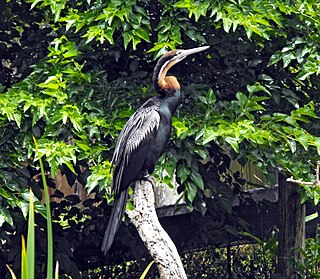
The darters, anhingas, or snakebirds are mainly tropical waterbirds in the family Anhingidae, which contains a single genus, Anhinga. There are four living species, three of which are very common and widespread while the fourth is rarer and classified as near-threatened by the IUCN. The term snakebird is usually used without any additions to signify whichever of the completely allopatric species occurs in any one region. It refers to their long thin neck, which has a snake-like appearance when they swim with their bodies submerged, or when mated pairs twist it during their bonding displays. "Darter" is used with a geographical term when referring to particular species. It alludes to their manner of procuring food, as they impale fishes with their thin, pointed beak. The American darter is more commonly known as the anhinga. It is sometimes called "water turkey" in the southern United States; though the anhinga is quite unrelated to the wild turkey, they are both large, blackish birds with long tails that are sometimes hunted for food.

Struthionidae is a family of flightless birds, containing the extant ostriches and their extinct relatives. The two extant species of ostrich are the common ostrich and Somali ostrich, both in the genus Struthio, which also contains several species known from Holocene fossils such as the Asian ostrich. The common ostrich is the more widespread of the two living species, and is the largest living bird species. The extinct genus Pachystruthio from the Late Pliocene-Early Pleistocene of Eurasia is one of the largest birds ever.

Ostriches are large flightless birds. They are the heaviest and largest living birds, with adult common ostriches weighing anywhere between 140-320 lbs and laying the largest eggs of any living land animal. With the ability to run at 70 km/h (43.5 mph), they are the fastest birds on land. They are farmed worldwide, with significant industries in the Philippines and in Namibia. Ostrich leather is a lucrative commodity, and the large feathers are used as plumes for the decoration of ceremonial headgear. Ostrich eggs have been used by humans for millennia.

Stegodon is an extinct genus of proboscidean, related to elephants. It was originally assigned to the family Elephantidae along with modern elephants but is now placed in the extinct family Stegodontidae. Like elephants, Stegodon had teeth with plate-like lophs that are different from those of more primitive proboscideans like gomphotheres and mammutids. The oldest fossils of the genus are found in Late Miocene strata in Asia, likely originating from the more archaic Stegolophodon, shortly afterwards migrating into Africa. While the genus became extinct in Africa during the Pliocene, Stegodon remained widespread in South, Southeast and East Asia until the end of the Pleistocene.

Aquila is the genus of true eagles. The genus name is Latin for "eagle", possibly derived from aquilus, "dark in colour". It is often united with the sea eagles, buteos, and other more heavyset Accipitridae, but more recently they appear to be less distinct from the slenderer accipitrine hawks than previously believed. Eagles are not a natural group but denote essentially any bird of prey large enough to hunt sizeable vertebrate prey.
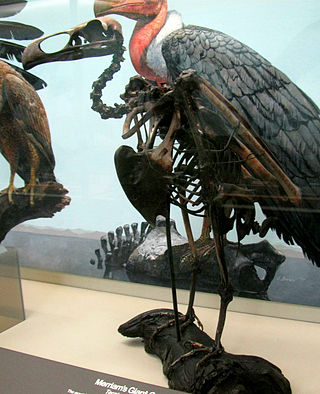
Teratornithidae is an extinct family of very large birds of prey that lived in North and South America from the Late Oligocene to Late Pleistocene. They include some of the largest known flying birds.
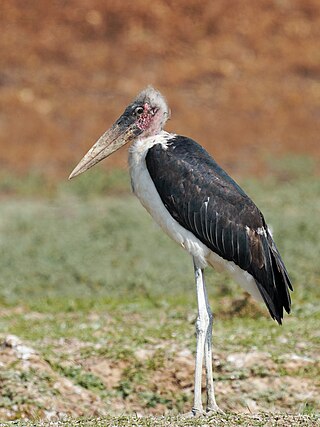
Leptoptilos is a genus of very large tropical storks, commonly known as adjutants. The name means thin (lepto) feather (ptilos). Two species are resident breeders in southern Asia, and the marabou stork is found in Sub-Saharan Africa.

Ciconia is a genus of birds in the stork family. Six of the seven living species occur in the Old World, but the maguari stork has a South American range. In addition, fossils suggest that Ciconia storks were somewhat more common in the tropical Americas in prehistoric times.
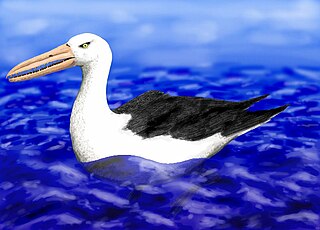
Osteodontornis is an extinct seabird genus. It contains a single named species, Osteodontornis orri, which was described quite exactly one century after the first species of the Pelagornithidae was. O. orri was named after the naturalist Ellison Orr (1857-1951).

The Pelagornithidae, commonly called pelagornithids, pseudodontorns, bony-toothed birds, false-toothed birds or pseudotooth birds, are a prehistoric family of large seabirds. Their fossil remains have been found all over the world in rocks dating between the Early Paleocene and the Pliocene-Pleistocene boundary.

Pelagornis is a widespread genus of prehistoric pseudotooth birds. These were probably rather close relatives of either pelicans and storks, or waterfowl, and are placed here in the order Odontopterygiformes to account for this uncertainty.
Aquila bullockensis is an extinct species of large true eagles in the family Accipitridae. A. bullockensis is related to the living species A. audax to which it might be ancestral. The species is solely known from the distal end of a right humerus found in the Middle Miocene, Bullock Creek deposits in Australia. A. bullockensis is the oldest confirmed record of the genus Aquila in Australia, and possibly in the world.

The Gypaetinae is one of two subfamilies of Old World vultures the other being the Aegypiinae. Some taxonomic authorities place the Gypaetinae within the Perninae hawks. They are presently found throughout much of Africa, Asia, and southern Europe, hence being considered "Old World" vultures, but as recently as the Late Pleistocene, they were also present in North America.
Pterodromoides is an extinct genus of fulmarine petrel dating from the Late Miocene. It contains a single species, P. minoricensis. Its fossil remains were first discovered at the Punta Nati palaeontological site on the island of Menorca in the Balearic archipelago of the western Mediterranean. An additional specimen from North Carolina, USA has also been referred to this species, suggesting it lived across the North Atlantic. It was described in 2001, with the authors justifying the creation of a new genus by the large orbitonasal opening and characters of the postcranial skeleton, despite the similarity of the cranial osteology to that of Pagodroma.

Dolichopithecus is an extinct genus of Old World monkey that lived in Europe during the Late Miocene and Pliocene.
Dryornis, also called the Argentinian vulture, is an extinct genus of cathartid, known from Argentina. The genus contains two species, D. pampeanus and D. hatcheri.

Afrocygnus is an extinct genus of swan, which lived during the Late Miocene, and perhaps up to the Late Pliocene, in what is today North Africa. The only genus of swan known in Africa, aside from fragmentary Pleistocene remains found in East Africa and from occasional observations of vagrant European swans along the Mediterranean coast, it lived in what was during the Miocene a damp wetland spanning from Libya to Chad, alongside the Antracothere Libycosaurus and the early Homininae Sahelanthropus. The genus is considered as the sister taxon of the extant genus Cygnus. Fossils of the genus have been uncovered in the Sahabi Formation of Cyrenaica in Libya, and in the Toros-Menalla locality in the Djurab Desert of Northern Chad.

Gavia schultzi is an extinct species of loon from the Middle Miocene of Austria. It is amongst the oldest known species in the genus and larger than the older Gavia egeriana from the Early Miocene Czech Republic.
















